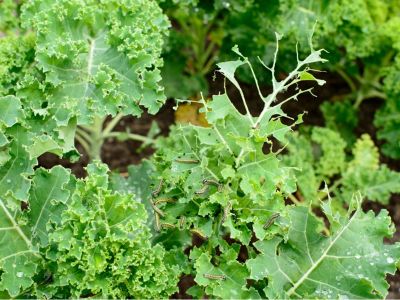Fungal Kale Plant Diseases
Fueled by longer nights, heavy dew and cooler temperatures, fungal diseases are the biggest problems gardeners are likely to experience in fall crops of kale. Add a few days of rain and the entire crop can be compromised. Here are the most common fungal diseases of kale crops:
Alternaria leaf spot (Alternaria brassicae or Alternaria brassicicola) – Symptoms include small, circular spots with concentric (target-like) rings. The rings can range in color from purplish-black, to gray or brown and sometimes the centers fall out.Anthracnose (Colletotrichum higginsianum) – This fungus makes dry yellow or gray spots which can be circular or irregular in shape. It’s more common in late summer or early fall when temperatures are in the 79 to 86 degree F. (26-30 C.) range.Black Leg (Phoma lingam) – Look for brown lesions on the stems of newly-sprouted seedlings. Black leg causes wilting, stem lodging and death. It can spread quickly.Damping Off (Fusarium, Pythium & Rhizoctonia ssp.) – As in spring sown crops, damping off can be caused by a number of fungal pathogens. This problem can be identified by a brown or black spot which girdles the stem of newly-sprouted seedlings and leads to loss of the plant.Downy Mildew (Hyaloperonospora parasitica) – This disease presents itself as grey to white colored fluffy spots on the underside of kale leaves. Both sides of the leaves can also have yellow or brown patches.Powdery Mildew (Erysiphe cruciferarum) – This fungal infection is easily recognized by the chalky white coating on the upper leaf surfaces. Gardeners might also notice the leaves of their kale yellowing or curling.White Leaf Spot (Cercospora or Cercosporella spp.) – Although white leaf spot is not common on kale crops, when present it appears as whitish spots bordered in brown.White Rust (Albugo candida) – This pathogen produces chalky white pustules which first appear on the underside of the leaves. Corresponding yellow patches appear on the leaf’s upper surface.
Proper garden hygiene is the best method for deterring fungal diseases. Clean up plant debris. Don’t compost infected plants or overwinter them in greenhouses and low-tunnels. Avoid overhead irrigation. Buy certified disease-free seeds from a reputable source and practice crop rotation.
Bacterial Diseases of Kale
Bacterial diseases on fall crops of kale are less common, but can be seen in conjunction with fungal infections:
Black Rot (Xanthomonas campestris) – Black rot initially appears as yellow, v-shaped lesions at the edge of leaves. These areas spread toward the stem as they turn black and become necrotic.Bacterial Leaf Spot (Pseudomonas syringae pv. maculicola) – The leaves of infected plants first develop small water-soaked lesions. These will turn black and have yellow borders.
Invertebrate Pests on Kale Plants
While bugs, such as flea beetles, are typically not a problem in fall crops, kale sown in late summer can still be afflicted by a number of pests during warmer months. Most either chew holes in the leaves or damage leafy green crops by sucking nutrients from the plants. Insects can also transmit plant diseases. Insect damaged leaves are seldom appetizing, even after a thorough washing. If you’re asking, “What bugs are eating my kale?” look for these common crucifer-loving pests on damaged leaves:
Beet Armyworms (Spodoptera exigua)Cabbage Aphids (Brevicoryne brassicaea)Cabbage Looper (Trichoplusia ni)Cross-striped Cabbage Worms (Evergestis rimosalis)Cutworms (Agrotis spp. and others)Diamond Black Moths (Plutella xylostella)Harlequin Cabbage Bugs (Murgantia histrionica)Thrips (Frankliniella occidentalis or Thrips tabaci)White cabbage butterfly larva (Pieres rapae)White Flies (Bemisia argentifolii)
